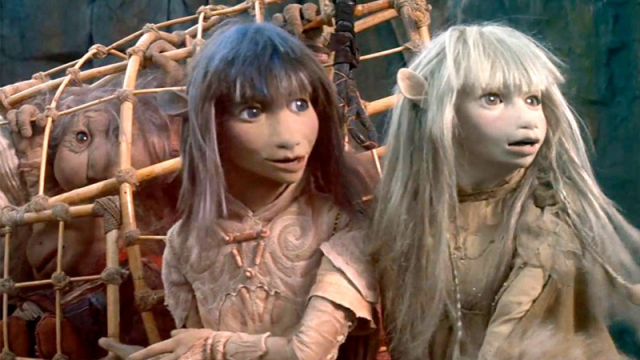Even as we’re just a week away from The Age of Resistance prequel series — itself a remarkable technical achievement — hitting Netflix, the puppet design and work of Jim Henson’s The Dark Crystal still stands as an incredible testament to practical effects. Aside from Henson and his team’s collective expertise with puppets, they had a teeny bit of help from the galaxy far, far away.
As the excellent making-of book The Dark Crystal: The Ultimate Visual History by Caseen Gaines notes, in the earliest stages of The Dark Crystal’s conception — known then, in jotted synopses and pitch drafts, as simply The Crystal — Jim Henson was eager to craft a world of puppets that looked unlike any of his work on the then-rising success of The Muppets.
It wasn’t just tone or genre that Henson wanted to distance himself from, but the physicality of the beings themselves: He didn’t want puppets that, like Kermit, were obviously made from felt and ping-pong balls. He wanted his fantasy project to star characters that felt real and as if they lived as part of an actual world.
In the earliest stages of conceptualisation, before pre-production on The Dark Crystal could ramp up in the late ‘70s, Henson formed an unlikely partnership that helped realise those dreams, and it was because of a certain follow up to a little picture called Star Wars.
In 1979, as work was beginning in earnest on George Lucas’ followup to his blockbuster space saga, the makeup and special creature designer on what would become The Empire Strikes Back, Stuart Freeborn, was struggling to bring a new character — the wizened Jedi Master Yoda — to life.
So Empire’s producer, Gary Kurtz, knowing that Henson was experimenting on a project using foam latex-covered puppets, turned to him to see what ideas Henson could bring to the table when it came to Yoda.
Kurtz offered Henson a collaborative deal: If Henson could give Empire’s production team some of his puppet design team in what would become the Creature Workshop — including the likes of designer Wendy Midener Froud, and puppeteers Frank Oz (who Henson had asked to co-direct his fantasy project), Kathyrn Mullen and David Barclay — Kurtz would come on board to what would eventually become The Dark Crystal as a producer and adviser.
And in turn, Henson’s designers and puppeteers would get a test case for all the ideas they wanted to use on The Dark Crystal in the form of a tiny green Jedi.
As Midener Froud told Gaines:
Yoda was the forerunner for everything we were trying on The Dark Crystal. It gave us a taste of what it was like using that kind of sophisticated puppet on a set when you had a limited amount of time and very elaborate scenes that you had to get done. That sort of training was vital to The Dark Crystal. Although we knew deep down inside what could and couldn’t be done, Yoda confirmed that for us in no uncertain terms.
While Oz, Midener Froud and several others working on The Dark Crystal took a sojourn to Dagobah, Henson had time to work on further drafts of the movie’s outlines, taking work from Oz and concept artist Brian Froud and handing it over to writer David Odell.
Odell’s version of the screenplay would go on to form a significant step in The Dark Crystal’s final form, scrubbing up concepts and adding ideas that would eventually make it into the film.
In the meantime, the work on Yoda wouldn’t just go on to change the galaxy far, far away; everything Oz and the rest of the team Henson had lent to the film were lessons learned to help bring the Gelflings, Skesis, Podlings and rest of Thra’s denizens to life in the enchantingly realistic way that would eventually earn The Dark Crystal its place in cinematic history.
Not bad for a bunch of little latex creatures.
[referenced url=”https://gizmodo.com.au/2019/08/the-dark-crystal-age-of-resistances-creators-and-writer-dig-deep-on-reinventing-a-classic/” thumb=”https://gizmodo.com.au/wp-content/uploads/2019/07/Screen-Shot-2019-07-22-at-11.54.10-am-410×231.png” title=”The Dark Crystal: Age Of Resistance’s Creators And Writer Dig Deep On Reinventing A Classic” excerpt=”The Dark Crystal is a beloved fantasy film whose legacy has almost become bigger than the movie itself. Released in 1982, the movie didn’t fare well in theatres, but it’s since gained a strong following and an expanded lore. So, what does Netflix’s The Dark Crystal: Age of Resistance bring to this growing universe, and how do you tell a story of hope when we know things don’t end well? We asked the creators.”]
